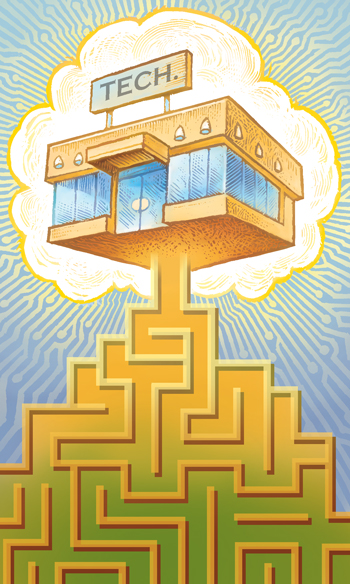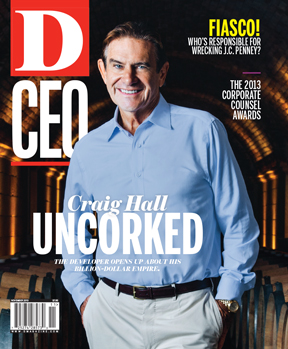You’ve probably heard by now that RadioShack’s new executives have started the hard work of rebuilding one of America’s most iconic technology brands. It won’t be easy, and it won’t happen overnight. But something is different this time. Consumer habits and tech trends have just about lined up well for RadioShack. It has a fighting chance, and so the next couple of years could show us a very different kind of retailer.
How come? For an answer to that, let’s look at what is happening in technology—and how consumers have responded. First, there’s the idea that consumers want lots and lots of choices. While it is true that consumers like choices, and they like to shop around, it’s also becoming more true that they crave focus and a good experience as well.
Over the last decade, Apple stores have destroyed the idea that consumers always prefer choice and are price-sensitive to new technology. While consumer technology is everywhere and working its way into every facet of our lives, Apple stores have become the ultimate curators of our consumer tech lives.
In general, this is because Apple stores are packed with people, not stuff. They feature clean tables, not 7-foot-high grocery store-style aisles. They have on-site tech support, not cashiers who may or may not know what you’re talking about. They teach classes right there in the store to show you how to do more, so that you can create more, so that you will consume more. At a time when low-cost brands flooded the market with computer accessories and tech gear, Apple stores rejected the notion of stocking “one of everything.” They almost never carried the cheapest version of anything.
Apple also understands that not everything works as an online purchase. We still buy a lot online, sure, but we prefer to make some purchases in person. A recent PricewaterhouseCoopers study of consumer buying habits said that 23 percent of consumers research consumer-electronics online and then go to a store to buy the product, compared to just 2 percent who do it the other way around.
It’s no surprise, then, that Apple stores hauled in nearly $6,000 per square foot in 2012, up 17 percent from the year before. In 2011, RadioShack, with twice the number of stores as Apple and, arguably, many more choices, saw its stores generate sales of less than $400 per square foot.
The big takeaway from Apple’s wild success in retailing is that an edited selection is better than unlimited choice. And that on-site training and support are critical to a good experience, especially for tech consumers.
CONNECTIVITY AND CONTENT
Another trend RadioShack should be mindful of is how it can use its network of stores to connect to customers.
Starbucks, in my opinion, is the reigning champ of taking its retail stores and using them like one vast network; each store is an Internet-connected piece of a larger, more meaningful experience.
I’ve visited Starbucks stores in four countries, and they all used connectivity and content in compelling ways. The company’s mission, interestingly, doesn’t say anything about up-selling flavor shots or pushing more merchandise. The Starbucks mission is to “inspire and nurture the human spirit … one neighborhood at a time.”
If it were focused merely on coffee, Starbucks wouldn’t be upgrading the Wi-Fi connections at 7,000 of its U.S. stores and, in the process, ditching Dallas-based AT&T in favor of Google as its technology partner.
The company says about 10 percent of all transactions done at Starbucks stores are done on mobile devices, so connectivity is critical. By getting millions of people to use its mobile app and connect in its stores, Starbucks has a better, more frequent reach to a targeted market than most of the world’s TV networks. And, unlike the world’s TV networks, Starbucks has the credit-card numbers of most of its mobile-app customers.
With its app, the retailer offers content that is exclusive to in-store customers (like streaming video of a live musical performance), then extends that store experience to the outside (free song downloads) and encourages more spending later on (by selling CDs and merchandise). In its Silicon Valley and Boston stores, the company is offering free phone-charging so coffee drinkers will stay longer and spend more.
Collapse all these data points together, and you see that Starbucks is as much a worldwide, digital entertainment and information network as it is a coffee shop. With more than 4.25 million Twitter followers and more than 10 million active users of its mobile apps, the company has figured out how consumer behavior changed when mobile devices started showing up everywhere.
While everyone else was just trying to sell phone cases, Starbucks used its stores and its technology to shorten lines, build loyalty, save money, make purchasing easier, and entertain its customers.
WE’RE ALL MAKERS NOW
Another significant trend shaping consumer behavior is that today’s creators are tomorrow’s best consumers. Smart brands, like Apple, are enabling this trend. The good news for RadioShack is that it saw this one coming. “It goes back to getting a clear focus of who our brand is for, and building experiences around that,” says Jennifer Warren, RadioShack’s new chief marketing officer.
Today’s do-it-yourselfers, sometimes called “Makers,” use technology to solve problems, and then create stuff for the fun of it.
RadioShack has wisely strengthened its partnership with Maker Media, whose increasingly popular Maker Faires combine the fun elements of a science fair, a state fair, and a picnic rolled in one free-for-all event. “It’s like ‘Burning Man‘ for families,” explains Sherry Huss, VP of Maker Media.
The Maker Movement is gaining strength on the back of several technology trends. The most important: open-source hardware and software is encouraging the same kind of widespread tinkering and building that we saw in the 1970s, when the computer revolution really kicked into gear.
This time around, though, the phenomenon is worldwide and instant, with Internet video making information easy to share, and dozens of media companies and blogs that are specifically devoted to curating and organizing DIY projects.
The price point for experimentation is low, too, which encourages more tinkering. A kit that includes the open-source microcontroller, Arduino, costs $30 and, by itself, the device is pretty generic. But that kit can power hundreds of projects. One online video shows how to build a solar-powered water sculpture for your garden, for example, with the Arduino controller as the “brains” of the feature.
Tech hobbyists have changed, too. Huss says her research shows that Makers tend to be well-educated, married homeowners with salaries in excess of $100,000 a year, and they’re generally among the first to adopt new technologies. The right local store with the right parts could provide a convenience that even the internet can’t match.
“As more and more kids start making and creating projects, we think the kids will be the ones bringing parents to stores,” Huss says.
Technology is in every part of our lives now, and it has changed how we shop. It has also changed what we expect from the places that claim to understand technology.
If I had to build a dream store for technology, it would be clean and carefully curated, with a helpful staff. It would use in-store connectivity and content to keep me informed, entertained, and coming back for more.
Huss sounds convinced that RadioShack’s Warren is heading in that direction. For her part, Warren says her team is looking at creating in-store experiences that are community-oriented and further amplify the interactive elements of the new store designs. “We’re rebuilding the entire store experience and brand around our best customers,” she says.
My dream technology store would also understand that we’re all, to some degree, Makers. And we’re likely to consume more if the process of creating is made as accessible and straightforward as possible. Finally, my dream store would let me listen carefully to a pair of $200 headphones before expecting me to plunk down some cash.
Could RadioShack become my dream store? That’s more possible now than it has been in the past 20 years. But RadioShack’s triumphs and troubles should also teach us that, for every big technology shift that happens, a change in consumer behavior might be just around the next corner.






